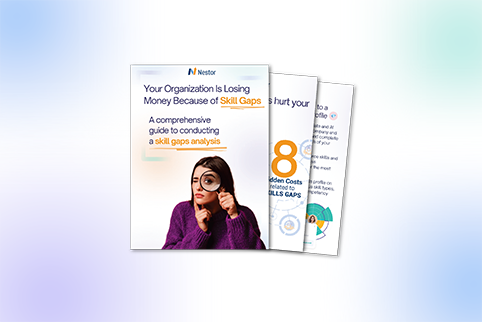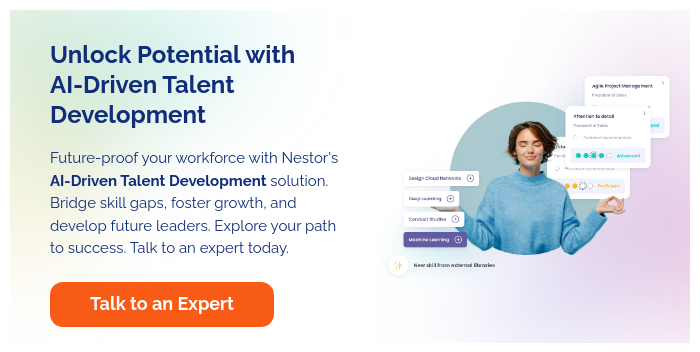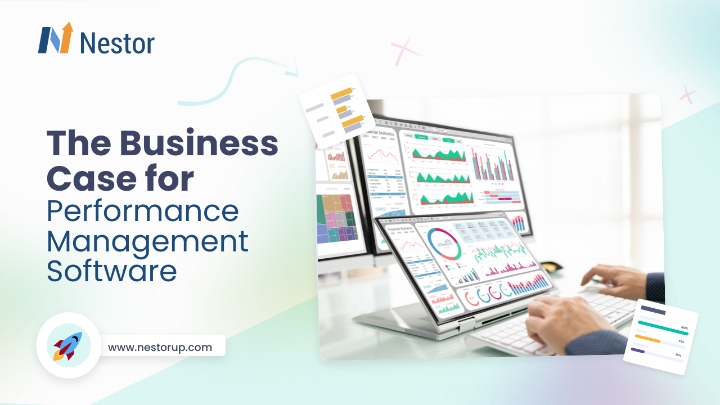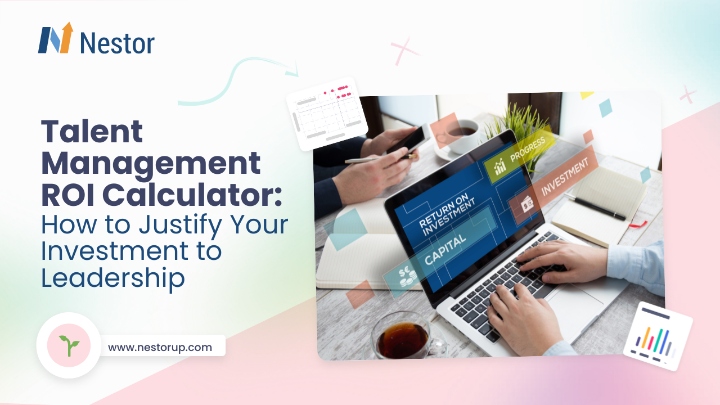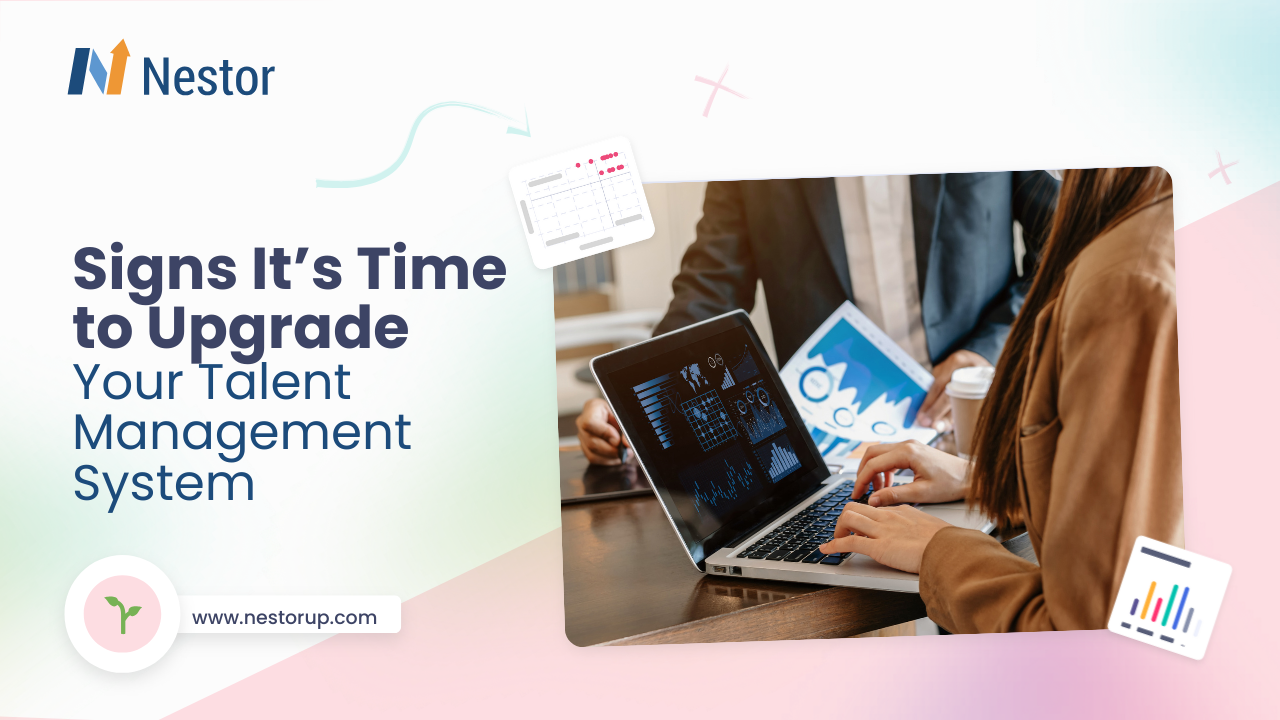
Contents
You can feel it before you can name it (if your talent management system needs a change). Processes that once worked fine now feel like friction. Hiring takes longer. Performance reviews are checked boxes, not conversations. People leave, not because they’re unhappy, but because they can’t see where they’re going next.
If you’re leading HR or a business unit, you probably sense the gap. Your current setup isn’t failing in any dramatic way, but it’s quietly getting in the way of growth. The system you use to manage talent — the processes, tools, and spreadsheets — might be the problem. Or at least part of it.
Let’s pause on that for a second.
At its core, a talent management system helps you understand your people: their skills, ambitions, performance, and potential. It supports managers, gives employees clarity, and helps leadership stay ahead of the curve. When it works well, the system fades into the background, letting better work, smoother collaboration, and real momentum take the lead.
But when it falls short? You feel the weight. And most times, it’s subtle. No loud alarms, just missed signals: someone gets promoted based on gut feel, not skill fit. Learning budgets go to waste because nobody knows what people actually need. Roles stay open while internal candidates are overlooked. It piles up.
If any of that sounds familiar, you’re not alone and you’re not imagining it. Many companies keep pushing forward with systems that made sense when they were smaller or when priorities were different. But teams grow. What once felt “good enough” slowly becomes a drag.
So how do you know when it’s time to change? That’s what this article is about. We’ll walk through a few common signs, ones that often get brushed off or explained away, and why ignoring them could cost more than you think. If you recognize more than a couple, it might be time to start looking at your next move.
And don’t worry, this isn’t about tearing everything down and starting from scratch. It’s about knowing what’s no longer working and what might serve you better.
Sign #1: Poor Skills Visibility Is Slowing Down Workforce Planning
Let’s say a new project kicks off, and you need someone with strong data skills. You scan your team in your head, ask a couple of managers, maybe even send a Slack message: “Anyone know someone good with Power BI?”
This is the problem.
When you don’t have clear visibility into the skills your people actually have not just what’s on paper, but what they’re capable of doing right now, you’re operating on guesswork. And guesswork doesn’t scale.
Most companies track skills reactively, if at all. A resume here, a training record there. But there’s no living, breathing snapshot of your workforce’s real capabilities. Which means workforce planning becomes a slow, frustrating game of connect-the-dots. And more often than not, you miss key people hiding in plain sight.
What’s the cost? Missed opportunities, for starters. People with the right skills don’t get tapped for projects or roles they’re more than ready for. You end up hiring externally when you could’ve promoted internally. It also eats away at morale because when employees don’t see a path forward, they start looking elsewhere.
A good talent management system flips that dynamic. It brings skills into focus automatically, continuously, and in context. It connects skills to roles, goals, performance data, and learning activities. So instead of chasing down answers, you’ve got a real-time map of who can do what, and where you might have gaps.
And when you can see your talent clearly, everything moves faster. Promotions feel fairer. Development gets targeted. Managers make better decisions. It’s not just about knowing who’s good with Power BI. It’s about being confident you’re using your people to their full potential.
Sign #2: Performance Reviews Are Static and Low-Impact
You know the drill. Once a year, maybe twice if you’re pushing it, managers fill out performance reviews. Employees do a self-assessment. There’s a rushed meeting, a few vague goals, a checkbox marked “complete,” and then… silence. Until next year.
This kind of process doesn’t reflect how people work anymore. Or how they grow.
Static reviews, the kind that only happen once a year, with little context and even less follow-up, often become a formality. They check compliance boxes, but don’t drive performance. They don’t support meaningful development. And they definitely don’t help managers coach in real time.
And that’s how you start missing out on insight. Talent is dynamic. People evolve constantly; new strengths, new struggles, different motivations. When your performance management system isn’t built to capture that rhythm, your decisions start to lag behind reality.
And it shows up in subtle ways:
- Goals that don’t match current priorities
- Feedback that’s vague or outdated
- Promotions that feel arbitrary
- High performers who don’t feel seen
The good news is that newer performance management system types are built for what people actually need: frequent, focused check-ins, real-time feedback, goal alignment that adjusts as the business shifts. Some also support things like 360 feedback, coaching frameworks, and peer recognition; tools that make performance feel human again.
When performance reviews work, they create momentum. People know where they stand, what they’re working toward, and how to get better. Managers become coaches, not just evaluators. And HR finally has the data to spot trends, not just problems.
If your current system can’t support that or worse, if your people actively avoid using it, it’s worth asking whether it’s helping at all.
Sign #3: Internal Mobility Is Stagnant
You’ve got open roles. You’ve got talented people. And somehow, those two things rarely meet.
Internal mobility sounds good in theory and most companies say they support it. But in practice, it often gets lost in the shuffle. Managers want to hold onto top performers. Job openings aren’t widely shared. There’s no clear path for someone in marketing to explore a role in ops, even if they’ve got the skills. So people stay put… until they don’t.
And when they leave, it’s rarely about money. More often, it’s because they stopped seeing a future. And turnover isn’t cheap either. Research suggests that replacing a single employee in 2025 could cost between 50% and four times that person’s annual salary, depending on the role and level of experience.
But low mobility doesn’t just affect retention. It also signals a deeper problem: your systems aren’t built to surface potential. If employees have to navigate politics, back channels, or luck to move around internally, something’s off. It also creates a talent block. You end up spending time and money recruiting for roles someone inside your company could’ve filled. If only they’d known it was an option…
This is where a modern talent management system makes a real difference. It connects the dots between people, skills, roles, and growth opportunities so mobility isn’t just possible, it’s obvious. Employees can explore potential moves based on their current strengths and development goals. Managers get visibility into who’s ready to step up. And HR can actually plan ahead instead of playing catch-up.
If your top performers can’t see what’s next, they’ll assume the answer is “nothing.” And that’s when you lose them.
Sign #4: Talent Data Is Fragmented Across Tools
You’ve got one platform for recruiting. Another for learning. A third for performance. Compensation lives somewhere else. And every time someone asks for a talent report, it means stitching together five exports and hoping the formatting doesn’t break.
Sound familiar?
When your talent data lives in silos, you’re losing insight. In fact, about 70 % of employees end up spending more than half their week chasing info across systems, just to get basic answers.
The information is there, but it’s scattered. That means you’re constantly reacting instead of making confident, informed decisions.
Here’s what fragmentation tends to look like day to day:
- Managers making development plans without access to learning history
- Recruiters guessing at internal candidates because skills data is buried
- HR teams spending hours building reports that are already out of date
- Employees being asked the same questions across multiple systems
It’s not just inconvenient. It slows everything down and clouds strategic thinking. You can’t spot performance trends if you can’t see them in one place. You can’t forecast skills gaps if your skills data is outdated or incomplete and you can’t prove impact if your metrics don’t line up.
A modern talent management system brings everything under one roof, or at least connects the dots between them. So when you look at an employee, you’re not just seeing their latest review. You’re seeing their goals, their strengths, their growth areas, and where they might go next. And you’re seeing it all in context.
If you’re still cutting and pasting from five tools just to answer basic questions, that’s a signal your system isn’t keeping up.
Sign #5: HR Processes Are Still Manual
You know it’s bad when onboarding a new hire means sending five emails, chasing down a manager for access, updating three spreadsheets, and finally realizing someone forgot to set them up in payroll.
Manual processes are exhausting. They drain time, create blocks, and open the door for human error. And when you’re growing or managing complexity across departments, those small inefficiencies add up fast.
You might notice your HR processes get stuck in the manual zone when you see signs like these:
- Performance reviews tracked in Excel or Google Sheets
- Learning paths shared via email and rarely updated
- Promotion requests bouncing around inboxes for weeks
- Managers guessing at career paths because there’s no system to guide them
- HR teams constantly re-building reports from scratch
It’s not that people don’t care. It’s that the tools don’t support the work. So everything takes longer than it should, and nobody has a clear view of what’s happening across the board. The result? HR ends up being reactive instead of strategic, buried in admin instead of shaping culture and growth.
A proper talent management system automates the repetitive stuff (reviews, approvals, nudges, goal tracking) so HR can focus on things that actually move the needle. And it gives managers tools they’ll actually use, not avoid. No more emailing reminders. No more chasing updates. Just smooth, connected workflows that actually make sense.
If your team is still running key people processes by hand, it’s not a badge of honor. It’s a red flag.
Sign #6: Your System Can’t Scale or Customize
It’s a common scenario: your company grows, teams change, goals shift… and your talent system still treats everyone the same.
What worked for a 100-person company starts to break when you hit 300. Or 1,000. Maybe you’re adding locations, new departments, or entirely new business units. But your system keeps pushing out the same templates, same workflows, same rigid structure, whether it fits or not.
When a system can’t bend, people find workarounds. HR builds side processes. Managers track goals in their own docs. Teams start ignoring the platform altogether. And suddenly, what’s supposed to keep things simple becomes another layer of complexity.
Here’s what this usually looks like:
- You can’t tailor performance criteria by department or role
- Review cycles don’t match your business rhythm, but you’re stuck with them
- Reporting is fixed and barely touches the questions leadership actually asks
- Every change requires IT support or vendor involvement
- New workflows feel bolted on instead of built in
The deeper issue? Lack of flexibility kills strategic agility. You end up designing your processes around your system, instead of your people and business goals. That’s the opposite of what a good talent management system should do.
Modern systems let you shape the experience, not just for HR, but for managers and employees, too. You can adjust timelines, tweak rating models, personalize learning journeys, and tailor goal frameworks by team.
If your platform can’t grow with your company, it’s not just outdated. It’s holding you back.
Sign #7: Low Employee Adoption and Engagement
If your talent system only gets used when people are forced to log in, that’s a problem.
Don’t look at engagement as a trivial metric. It matters for retention. Employees who move roles internally are 3.5 times more likely to stay engaged at work. And if they’ve shifted roles by year two, there’s a 75% chance they’ll still be there, compared to just 56% of those who haven’t.
You can build the most well-intentioned performance process, or the most thorough learning path, but if the platform is clunky, slow, or irrelevant to people’s day-to-day, they’ll avoid it. Quietly. Consistently. Until eventually, you’re left with a system that looks great on paper and completely fails in practice.
Low adoption isn’t just about tech frustration (though that’s often part of it). It usually points to a deeper disconnect: the system isn’t adding real value for the people using it. They don’t see what’s in it for them. They’ve used outdated tools before and learned not to trust new ones to be any different.
Some familiar red flags:
- Employees only log in around review time, and even then, reluctantly
- Managers find it easier to track goals elsewhere
- Self-assessments feel rushed or meaningless
- Most teams barely use the feedback tools
- The mobile experience either doesn’t exist or falls short
When engagement drops, the system starts to erode from the inside out. Data gets stale. Feedback loops disappear. People development stalls. And HR loses the visibility it needs to make real decisions.
The fix isn’t just “make it prettier.” It’s about usefulness. A good talent management system makes itself relevant by simplifying workflows, surfacing helpful insights, and actually supporting the conversations people are already having. It respects people’s time, works the way they work, and makes the whole process feel natural.
And yes, design matters too. If a tool feels like it was built in 2006, people are going to treat it that way. A modern, intuitive experience, with self-service functionality, mobile access, and clear benefits for everyone involved makes adoption less of a struggle and more of a given.
What a Modern Talent Management System Should Deliver
So you’ve seen the signs. Maybe not all seven, but enough to feel the drag. The question now is what should your system actually do?
A modern talent management system isn’t just a digital filing cabinet. It’s a tool that supports real work, real people, and real progress. When it works right, the system steps back while your team makes faster decisions, moves careers forward, and stays aligned, without constant hand-holding from HR.
Let’s break it down.
1. Live Skills Intelligence, Not Just Job Titles
You don’t need a static chart. You need a living map of who can do what, where they want to go, and what it’ll take to get there.
A solid system should:
- Capture current skills, not just certifications
- Connect skills to roles, projects, and growth paths
- Highlight gaps early so you’re not hiring in a panic later
- Update continuously, not once a year during review season
2. Performance Management That Actually Drives Performance
Tick-the-box annual reviews are out. What works now is fluid, ongoing, and tied to actual business goals.
Look for features like:
- OKRs or goal frameworks that adjust as things change
- Built-in check-ins and feedback loops
- Peer and upward feedback (when it makes sense)
- A clear link between performance and development
This is where performance management system examples come in handy. If your current system can’t do what modern tools are doing, it’s probably behind.
3. Career Growth That Feels Achievable, Not Abstract
Internal mobility shouldn’t be a mystery. People should be able to see their next step and know what they need to get there.
That means:
- Clear career pathing tools
- Skill-to-role matching
- Learning suggestions tied to individual growth goals
- Internal opportunity visibility (not just “we post roles internally”)
It’s not about overpromising promotions. It’s about showing people progress.
4. All Talent Data in One Place
No more logging into five tools to get a half-answer. Your talent system should connect performance, development, learning, goals, and even engagement, or at least integrate easily with platforms that do.
When that happens:
- Reports take minutes, not days
- Data quality improves because people are using the system
- Decisions get faster and feel less political
- You can finally spot patterns that were hiding in the noise
- Strategy becomes proactive, not reactive
And that last one really matters.
Only 12% of HR leaders in the U.S. say they plan their workforce three years out or more. Which means most companies aren’t planning talent, they’re patching it. A modern system should help you get ahead, not just catch up.
5. Workflows That Actually Work
You shouldn’t need a developer just to adjust your performance cycle. And managers shouldn’t need a tutorial to approve a promotion.
You need:
- Customizable review and feedback cycles
- Flexible goal-setting structures
- Easy role-based access for HR, managers, and employees
The point is to make HR run smoother, not heavier.
6. A User Experience That Doesn’t Feel Like a Chore
People won’t use tools that feel dated, confusing, or clunky. A modern TMS needs to look and feel like something people actually want to open.
That means:
- Mobile-friendly design
- Personalized dashboards
- Fast load times, clean navigation
- Tools that support conversations
Adoption isn’t a training issue; it’s a design issue. Fix that, and the rest gets easier.
That’s what the new standard looks like. Not perfection, just a system that fits the way people work now.
Why Nestor Might Be the Talent Management System You Actually Need
If you’ve been nodding along to the signs we covered earlier, you’re probably thinking: “Okay, but what system actually solves this stuff?”
That’s where Nestor comes in.
Unlike many traditional HR platforms that feel rigid or disconnected, Nestor was built to reflect how people actually grow through skills, conversations, and opportunity. It combines real-time skills intelligence with performance tools and internal mobility features, all in one place.
So instead of juggling tools, you’re connecting the dots.
Here’s what makes it different:
- Real skills visibility — not static lists, but dynamic skills data tied to roles, goals, and development.
- Continuous performance tools — check-ins, feedback, and goal-tracking that actually get used.
- Built-in career mobility — so internal talent doesn’t get overlooked or lost.
- Data that connects — skills, performance, and growth in one place (finally).
- A user experience people won’t resist — intuitive, clean, and built for how teams actually work.
If your current system creates more work than it solves, Nestor flips that. It gives HR and business leaders clarity, and gives employees something that feels relevant, not burdensome.
And it does all of that without needing a six-month implementation or a manual the size of a novel.
So, How Do You Know It’s Time to Make a Change?
Most companies don’t switch talent systems because of one big failure. It’s usually a slow build, a few clunky processes, a few missed signals, a sense that things aren’t working like they should.
If more than a couple of the signs in this article hit close to home, that’s your cue.
You don’t need to overhaul everything overnight. But it’s worth asking a few honest questions:
- Are your people easy to understand, develop, and retain or does it feel harder than it should?
- Can managers make confident decisions about growth, performance, and fit?
- Does your current system give you clarity… or just more admin work?
If you’re leaning toward the second half of those questions, it might be time to re-evaluate the tools you’re using and whether they still fit the way your company actually operates.
And if you’re not ready to switch systems just yet, that’s fine. Start with a quick audit. Talk to your team. Look at what’s being used and what’s being ignored. That alone will give you insight into whether your current setup is supporting progress or quietly stalling it.
Because at some point, it’s not just about what the system can do. It’s about whether it’s helping your people do their best work, or getting in the way.
Not Sure Yet? That’s Exactly the Right Place to Start
You don’t need to commit to anything today. But if your current system feels more like duct tape than strategy (slow reviews, scattered data, missed talent), it’s worth seeing what something better looks like.
Nestor was built for teams that outgrew the “just okay” systems.
It brings performance, skills, and growth into one place without turning every process into a project.
If you’re curious, let’s talk. No pressure. Just a real look at how Nestor works and whether it makes sense for where you’re headed.
👉 Book a quick demo and get back to managing talent, not just the tools around it.
Frequently Asked Questions About Talent Management Systems (For When You’re Still Figuring It Out)
What is a talent management system, exactly?
It’s a platform that helps HR and leadership manage key areas of the employee lifecycle like performance, learning, internal mobility, skills tracking, and career development. It brings all of that into one place so you’re not juggling separate tools.
What should a talent management system include?
At minimum, it should cover:
- Performance management
- Goal setting and tracking
- Skills assessment
- Career pathing
- Internal mobility
- Learning integration
- Reporting and analytics
The best systems also allow for customization, automation, and seamless user experience, otherwise, adoption tanks fast.
How is a performance management system different from a talent management system?
Think of performance management as one part of the whole. It focuses on employee goals, check-ins, feedback, and evaluations. A full talent management system includes performance but also covers skills, growth, learning, and internal movement.
How do I know our current system is the problem?
You’ll usually see early signs like:
- Managers avoiding the platform
- Employees unclear about goals or development paths
- Performance reviews that feel like a formality
- No visibility into skills or growth readiness
- HR spending too much time on admin instead of strategy
What does “skills visibility” mean in a talent system?
It means having a real-time view of what your employees are actually capable of beyond just job titles or resumes. This helps with workforce planning, internal recruiting, and development.
How does a talent management system support internal mobility?
By connecting skills, interests, and career paths with open roles or upcoming opportunities. A strong system surfaces hidden talent and helps employees see a future inside the company which cuts down on turnover and recruiting costs.
Do I need a full suite, or can I start small?
Some platforms are modular, so you can start with performance and expand into skills or career planning. Others are bundled. It depends on your current pain points and how much change your team can realistically handle.
What if my team hates using our current HR system?
That’s a sign the experience is off. People don’t avoid good tools. They avoid bad UX, confusing workflows, and systems that feel disconnected from their work. Adoption is a strong signal of whether your system is actually helping.
How long does it take to switch talent management systems?
It depends on the provider. Some platforms require a heavy lift and months of setup. Others, like Nestor, are built for faster implementation and easier configuration, without needing an army of consultants.
How is Nestor different from other talent management systems?
Nestor combines skills mapping, performance tracking, and internal mobility in one intuitive platform. Unlike traditional systems that focus on checklists and compliance, Nestor gives you live visibility into skills, connects growth with performance, and helps surface internal talent before it slips away. It’s simple enough for managers to actually use, and powerful enough to drive real talent decisions.
Is Nestor only for HR teams, or can managers and employees use it too?
Nestor is built for everyone; HR, managers, and employees. Managers get clear, easy-to-use tools for check-ins, feedback, and growth planning. Employees explore career paths, track their progress, and update their skills without getting buried in admin tasks. Meanwhile, HR gains the visibility and data to steer strategy, not just push paperwork.



